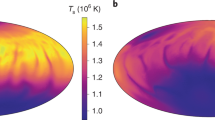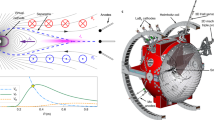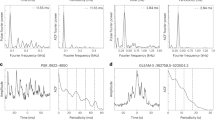Abstract
There is no agreement in reports on the oblique-rotator model of pulsars1–9 as to the site of emission within the pulsar magnetosphere. It is generally assumed, however, that the plasma-electromagnetic fields constituting the magnetosphere obey the quasistatic constraint ∂f/∂t = -ω0∂f/∂φ, where ω0 is the angular frequency of rotation of the central neutron star, t the time, and the cylindrical coordinates (r, φ, z) refer to an inertial frame whose z-axis is coincident with the axis of rotation of the star. Accordingly, the pulsar emission is attributed to a source whose distribution has a rigidly rotating pattern; though, of course, none of the charged particles which constitute the source and provide the medium for the propagation of the pattern associated with the source, are themselves constrained to be co-rotating. Here, the spectral distribution of the power emitted by such a rotating pattern is calculated and it is shown that electromagnetic radiation of frequency to ω ≫ ω0, the observed radiation from pulsars, is produced predominantly by the electric currents at the light cylinder r = c/ω0 of the magnetosphere. This is a model-independent result; it is valid irrespective of the type of emission mechanism and applies to all previously proposed models of the magnetosphere which are quasistatic and in which the radial length scale of the plasma distribution is of the order of c/ω0.
This is a preview of subscription content, access via your institution
Access options
Subscribe to this journal
Receive 51 print issues and online access
$199.00 per year
only $3.90 per issue
Buy this article
- Purchase on Springer Link
- Instant access to full article PDF
Prices may be subject to local taxes which are calculated during checkout
Similar content being viewed by others
References
Mestel, L. Nature phys. Sci. 233, 149–152 (1971).
Cohen, J. M. & Rosenblum, A. Astrophys. Space Sci. 16, 130–136 (1972).
Roberts, D. H. & Sturrock, P. A. Astrophys. J. 181, 161–180 (1973).
Endean, V. G. Astrophys. J. 187, 359–360 (1974).
Henriksen, R. N. & Norton, J. A. Astrophys. J. 201, 719–728 (1975).
Mestrel, L., Wright, G. A. E. & Westfold, K. C. Mon. Not. R. astr. Soc. 175, 257–278 (1976).
Cheng, A. F. & Ruderman, M. A. Astrophys. J. 212, 800–806 (1977).
Buckely, R. Mon. Not. R. astr. Soc. 183, 771–778 (1978).
Arons, J. & Scharlemann, E. T. Astrophys. J. 231, 854–879 (1979).
Jackson, J. D. Classical Electrodynamics. (Wiley, New York, 1962).
Ardavan, H. Astrophys. J. (submitted).
Landau, L. D. & Lifshitz, E. M. The Classical Theory of Fields (Pergamon, Oxford, 1962).
Abramowitz, M. & Stegun, I. A. Handbook of Mathematical Functions (Dover, New York, 1965).
Author information
Authors and Affiliations
Rights and permissions
About this article
Cite this article
Ardavan, H. Is the light cylinder the site of emission in pulsars?. Nature 289, 44–45 (1981). https://doi.org/10.1038/289044a0
Received:
Accepted:
Issue Date:
DOI: https://doi.org/10.1038/289044a0
This article is cited by
-
Polar cap models for pulsars
Nature (1981)
-
Polar cap models for pulsars (reply)
Nature (1981)
Comments
By submitting a comment you agree to abide by our Terms and Community Guidelines. If you find something abusive or that does not comply with our terms or guidelines please flag it as inappropriate.



